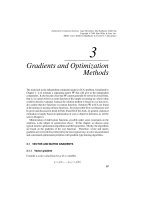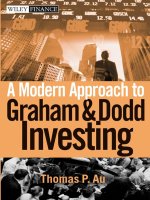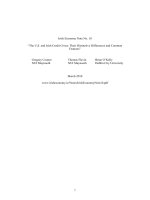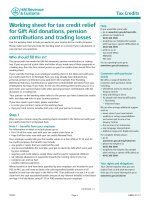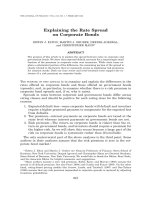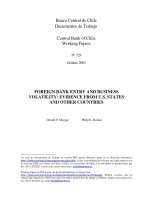Taxable and Business Income ppt
Bạn đang xem bản rút gọn của tài liệu. Xem và tải ngay bản đầy đủ của tài liệu tại đây (203.31 KB, 17 trang )
This PDF is a selection from an out-of-print volume from the National
Bureau of Economic Research
Volume Title: Taxable and Business Income
Volume Author/Editor: Dan Throop Smith and J. Keith Butters
Volume Publisher: UMI
Volume ISBN: 0-870-14118-X
Volume URL: />Publication Date: 1949
Chapter Title: Interest, Purchase and Retirement of Bonds, Bond Premium
and Discount
Chapter Author: Dan Throop Smith, J. Keith Butters
Chapter URL: />Chapter pages in book: (p. 124 - 139)
CHAPTER 6
Interest, Purchase and Retirement of Bonds,
Bond Premium and Discount
A INTEREST
THE INTERNAL REVENUE CODE, SECTION 23(b), PROVIDES IN
simple terms for a deduction of
"All interest paid or accrued within the taxable year on indebted-
ness, except on indebtedness incurred or continued to purchase or
carry obligations (other than obligation of the United States issued
after September 24,
1917, and
originally subscribed for by the
taxpayer) the interest from which is wholly exempt from taxes
imposed by this chapter."
Though the statement is apparently clear and unambiguous,
its application has aroused much litigation and controversy.
To a considerable extent the problems have arisen in connec-
tion with what, to the uninitiated, must seem rather unusual
business relationships. Some transactions, in fact, appear to
be in the form they are primarily to gain the tax advantage of
the interest deduction. To prevent abuse of the allowance for
interest deductions, various rules have been set up that must
be met before an interest deduction is allowed; for example,
the interest must have been paid on a bona fide debt and the
debt must be that of the payer.
None of the special rules is likely to be of any significance to
corporations with bonds or debentures outstanding, or in cases
involving loans from banks, finance companies, public lend-
ing agencies, and other disinterested lenders. Most of the
.124
CHAPTER 6 125
exceptions and qualifications to interest deductions relate
primarily to abnormal conditions in closely held corporations
or other situations in which maneuvers to avoid taxes have
been undertaken. The arithmetical computation of interest
paid or accrued, ignoring bond premium and discount, is sim-
ple. However, though tax and accounting practice may agree
on the amount, some part may be disallowed in computing tax-
able income if allowance would permit tax avoidance. But any
full discussion of the accounting treatment of these infrequent
pathological situations would be unreasonably long.
Whereas one concern Of the revenue agent is to make certain
that a deduction is not claimed for payments on debts owed by
someone other than the taxpayer, the concern of auditors for
public reports is to see that all debts of the company and in-
terest on them are included in the accounts. Omission rather
than improper inclusion is the danger. Interest paid by a cor-
poration on debts of employees or stockholders to third parties
is in the nature of additional compensation or a distribution of
profits, if not actually a misuse of corporate funds. There is a
real tax advantage in claiming a payment of interest on a stock-
holder's debt in a family corporation as interest paid by the
company, since the stockholder gets the benefit from a distribu-
tion of corporation funds of a sort which, contrary to the gen-
eral rule, would be deductible by the corporation in computing
its own income. Although such payments might be included as
interest paid in carelessly drawn statements, audited statements
would be properly qualified to indicate the exact nature of the
payment. The only cases in which a company issuing public re-
ports is likely to have paid interest on debts other than its own
are those involving guaranteed debts of subsidiary corporations
—a problem of consolidated statements and returns beyond the
scope of this study.1
1 One special situation, which as a practical matter would arise only in closely
held family corporations, is covered by Section 24(c) of the Internal Revenue
Code: No deduction will be allowed for ordinary and necessary expenses
[covered by Sec. 23(a)] or for interest (covered by Sec. 23(b)] if they are not
126
PART ONE
Very real possibilities exist for different treatment for tax
and book purposes of the interest element in the cost or pur-
chase price of property acquired. Some part of the total pay-
ment may be recognized as interest arising because payments
are deferred, and treated as such for book purposes, even
though the amount is not deductible as interest for tax pur-
poses because it does not meet the technical requirements
previously discussed. In this case, book income would be lower
than taxable income because of the interest deduction taken
when the property was paid for. But though taxable income
does not reflect the interest deduction, other factors would
operate to make taxable income lower than book income in
the same or later periods. The higher original cost of the prop-
erty would be reflected in the cost of goods sold, through in-
ventory, or in a higher basis for depreciation or for gain or loss
calculations. The higher cost as computed for tax purposes
could be expected to balance out over a period the immediate
interest deduction taken for book purposes.
The two statutory limitations on the deduction of interest
paid on indebtedness to purchase or carry securities yielding
tax-exempt interest have no counterpart in business account-
ing. Since all income, whether taxable or tax-exempt, is in-
cluded in measuring business income, no reason Sexists for
treating interest paid on funds borrowed to purchase tax-
paid within the taxable year or within two and one-half months thereafter,
and if the amount is not includible in the gross income of the person to whom
the sums are payable, and if the taxpayer and the person to whom the payment
is to be made are persons between 'whom losses would be disallowed under
Section 24(b).
Section 24(b) covers transactions between members of a family and in other
cases where arms-length dealings are unlikely. The accrued interest payable
would be a business expense in measuring the income of a borrower on an
accrual basis regardless of the nonpayment of the interest and the nonrecognition
of the interest receivable by the creditor on the cash basis. In audited statements
the unusual nature of any such continuously growing 'accrued interest payable'
item would call for explanation. The disallowance of interest .accrued but not
paid in certain conditions did not become effective until 1937,
and,
of course,
influences the taxable income figures only since that date.
CHAPTER 6
127
exempt securities any differently from interest paid on funds
borrowed for general purposes. The disallowance of such in-
terest for tax purposes will balance to some extent the non-
inclusion of the income from tax-exempt securities. But if
tax-exempt securities are held, the net effect of interest paid
and received would be the same for taxable and book income
only if nonincluded income and nondeductible interest were
exactly equal, an unlikely case.
B PURCHASE BY A CORPORATION OF ITS OWN BONDS
Many controversial problems center about the purchase by a
corporation of its own bonds. The important question is often
whether rather than when an item is income. The Supreme
Court has held that when a corporation purchases its own
bonds issued at par for less than par, the difference is income.2
Various important exceptions have been made to this general
rule. In a May 1946 Tax Court case a distinction was made be-
tween bonds purchased by direct negotiation with holders and
those purchased in the open market.3 For the former, it was
held that no income arose, and that the transaction came under
the doctrine of the American Dental Company case establish-
ing a rule that in certain situations a purchase at less than face
value involved a gratuitous cancellation of debt, i.e., there was
no taxable income.4 The open market purchases were held to
give rise to taxable income under the rule of the Kirby Lumber
case. Six members of the Tax Court dissented from the ma-
jority opinion, and whether the distinction according to the
form of the transaction is sufficiently real to be upheld is ques-
tionable. It is altogether unreal as a reason for varying treat-
ment for business purposes.
The Revenue Act of 1939 provided that under certain con-
ditions income arising from the discharge of indebtedness, by
the purchase of bonds at less than the issuing price, might be
2
U.S.
v. Kirby Lumber Company, 284 U.S. 1
(1931).
3
Lewis F. Jacobson v. Commissioner, 6 T.C. 1048 (1946).
4 Helvering v. American Dental Company, 318 U.S. 322 ('943).
-
- w
128
PART ONE
excluded from gross income. However, any such exclusion
must be offset by a reduction in the basis of property held by
the corporation.5 This provision was designed to facilitate ad-
justments of capital structures. Without it, corporations found
themselves in the anomalous position of incurring large tax
liabilities requiring cash paymentsas the result of events that
in no sense gave rise to cash receipts; rather the contrary. Some
of the original restrictions were removed by the Revenue Act
of 1942, and the expiration date, originally set at December3i,
1945, has been successively extended to December 31, 1949.
In the Revenue Act of 1942 more liberal treatment was ac-
corded railroad companies in case of modification or cancella-
tion of indebtedness pursuant to a court order in bankruptcy
or equity receivership proceedings. In such cases the exclusion
from gross income was absolute and not associated with an ad-
justment of basis of property.° This provision too was suc-
cessively extended to the end of 1949. The general effect of
these two exceptions is to bring the taxable income concept
more nearly in line with the concept of business income, which
in no case would include gains arising from distress recapital-
ization as income. The first exce.ption is sufficiently broad to
cover other than distress activities, but the provision for an
adjustment in basis and the phrase 'discharge of indebtedness',
which precludes trading in a company's own bonds, are im-
portant limitations.
C BOND PREMIUM AND DISCOUNT
Tax Treatment
Two types of question arise in connection with bond discount
and premium and with the expenses of issue or
Do certain items enter the computation of income at any time?
When should the income or the deduction be reported? The
5
Revenue
Act of 1939,Sec.215;
flOW Internal
Revenue Code, Sec. 22(b)(9). For
effects on basis, see Internal Revenue Code, i
6 Internal
Revenue Code, Sec. 22(b)(lo); Revenue Act of 1942,
Sec.
1i4(b).
CHAPTER 6
129
problems are difficult to separate. The legal provisions and
court opinions on this subject are presented rather fully as
examples of the highly technical nature of the taxable income
concept and of the rather arbitrary features that have at times
•characterized it.
i
Bond premium
The Supreme Court has taken the position that bond premium
is income and not a loan to the corporation which must be
amortized over the life of the bonds in the form of smaller in-
terest deductions. In the leading group of cases, the Old Colony
Railroad had issued bonds prior to 1913 at a premium.7 The
Commissioner contended, in considering the return filed for
the tax year 1920, that the income represented by the premium
should be amortized over the life of the bonds, in accordance
with the then existing regulations. The Board and Circuit
Court held, against the Commissioner, that the premiums were
income when received, that is, before the adoption of the i6th
Amendment.
Later, in connection with the 192 i tax year, the question of
the treatment of the premium again came before the Court.
This time the Commissioner contended that the deduction for
interest expense should be reduced by a pro rata part of the
premium, not that a pro rata part of the premium should be
included in income. The Circuit Court accepted the theory of
the Commissioner. Upon appeal, the Supreme Court held that
the premiums were income in the year received and had be-
come capital before the adoption of the i6th Amendment. The
Court refused to accept the theory that bond premium is in the
nature of capital lent by the bondholder which must be re-
turned over the life of the bond; that each payment of interest
is in part interest at the effective rate and in part a pro rata re-
7 Old Colony Railroad Company v. Commissioner, 6 B.T.A. 1025 (1927), relating
to the 1920 taxable year; affirmed 26 F(2d) 408 (CCA 1st, 1928); appeal dismissed,
279 U.s. 876 (1929). Old Colony Railroad Company v. Commissioner, i8 B.T.A.
267 (1929), relating to the 1921 taxable year, reversed 50 F (2d) 896 (CCA 1st,
1931), reversed 284 U.S. 552 (1932).
130
PART ONE
turn of the premium. The decision departs widely from ac-
counting theory in holding that 'interest' in the statute refers
to interest as it is popularly understood, not to the accountant's
concept of 'effective interest'.
"In the ordinary affairs of life no one stops for a refined analysis
of the nature of a premium, or considers that the periodic payment
universally called 'interest' is in part something wholly distinct—
that is, a return of borrowed capital. It has remained for the theory
of accounting to point out the refinement
. Inshort, we think
that in the common understanding 'interest' means what is usually
called interest by those who pay and those who receive the amount
so denominated in bond and coupon, and that the words of the
statute permit the deduction of that sum and do not refer to some
esoteric concept derived from subtle and theoretic analysis." 8
The Court's decision on the theory of bond premium has
not changed: the premium is considered income, not a factor
reducing the coupon rate of interest to the effective rate. But
granted that
premium is income, the second question
still remains: when is the income realized?
The Old Colony case involved bond premiums received be-
fore March 1, 1913. The Court held that the premiums were
income in the year they were received; they had therefore be-
come capital before the Income Tax Amendment was adopted
and could not be taxed under any subsequent income tax acts.
The constitutional question concerning the year when the
income is taxable, however, is irrelevant for bonds issued at a
premium since February 28, 1913. The Board has held that, on
the accrual basis, the amortization of the premium over the life
of the bonds properly reflects income;
that is, the premium
is gain or income which should be amortized over the life of
8 Old Colony Railroad Company v. Commissioner, 284 U.S. 552 (1932); see
discussion of this case in an editorial note, Harvard Law Review, Vol. 45, p. iii
6
(1931-32).
9
Chicago and Northwestern Railway Company v. Commissioner, 22 B.T.A.
1407,(1931),
reversed on another point 66 F(2d) 6i (CAA-7th, 1933);
Fall
River
Electric Light Company v. Commissioner, 23 B.T.A. i68
Regulations
iii,Sec.
29.22(a)-17.
CHAPTER 6
131
the bonds. On bonds issued at a premium before March i, 1913
the premium is gain or income for the year the bonds were
issued and should not be amortized over the life of the bonds.
2
Bond discount
Much of the inconsistency in the tax law between the treat-
ment of income and deduction items arises from the constitu-
tional problem of income realized before March i, 1913. When
income has been realized before the enactment of the i6th
Amendment, it cannot later be taxed as income. In the case of
deductions, income and capital are not strictly differentiated.
The problem of a tax levied on what cannot constitutionally
be taxed does not arise in handling deductions. Because of the
absence of a constitutional barrier, the tax treatment of deduc-
tions may often more closely parallel accepted accounting treat-
ment.
The Supreme Court has held that a taxpayer on the accrual
basis may amortize discount and commissions on bonds issued
before March 1, over the life of the bonds.1° The Old
Colony case was specifically distinguished on the ground that it
involved the question of income realized prior to the i6th
Amendment. The Court seems, however, to have retreated
from the theoretical position held
the Old Colony case that a
bond premium is not a factor of the effective interest rate. In
the Union Pacific case it approached nearer to accounting con-
cepts:
"Both commissions and discount, as the Government concedes, are
factors in arriving at the actual amount of interest paid for the use
of capital procured by a bond issue. The difference between the
capital realized by the issue and the par value, which is to be paid
at maturity, must be added to the aggregate coupon payments in
order to arrive at the total interest paid."
The regulations, Section 29.22(a)-17, on bond discount do
not differentiate between bonds issued before and after March
1, 1913, but state generally: "If bonds are issued by a corpora-
10
Helvering
v. Union Pacific Railroad Company, 293
U.s.
282
—
0
132
PART ONE
tion at a discount, the net amount of such discount is deduct-
ible and should be prorated or amortized over the life of the
bonds."
The Court, in the Union Pacific case, treated bond discount
and commissions alike. The regulations do not mention the
amortization of commissions and expenses; nevertheless, the
practice of the Bureau of Internal Revenue is not to differenti-
ate in the treatment of bond discount, expenses, and com-
missions.
3
Treatment of unamortized discount and premium when
bonds are redeemed
The law is well established, at least with respect to taxpayers
on the accrual basis, that bond discount must be amortized over
the life of the bonds. Controversy exists, however, concerning
the treatment of unamortized bond discount when bonds are
redeemed: Since bonds are frequently retired at a premium,
the premium paid upon redemption is an additional factor to
be considered. Are these items of unamortized discount and
premium paid on retirement deductible in the year of redemp-
tion? Are the deductions lost altogether? Or, in case the bonds
are retired by exchange for a new issue, are the amounts to be
amortized over some futureperiod?
The law is not clearly settled on some of the problems aris-
ing in connection with the redemption of bonds; highly tech-
nical distinctions have been drawn with the emphasis often
upon the form of the transaction. Bonds redeemed for cash are
differentiated from bonds retired by exchange for a new issue.
When bonds are redeemed for cash, the unamortized discount
and the premium paid upon retirement are deductible in the
year of retirement.1' Although the cash used for the redemp.
11 Present Treasury rulings are summarized in Cumulative Bulletin XIV-2,
p. 58, (1935),
revoking
an earlier ruling that when the funds used for retirement
were acquired from another bond issue, any unamortized discount and redemp-
tion premium should be amortized over the life of the new bonds. T.D. 4603
followed a series of cases holding for the taxpayers against the former interpre-
tation.
CHAPTER 6
tion may be obtained by the sale of another bond issue, the dis-
count, premium, and expenses need not be amortized over the
life of the new issue.'2 The theory is that the two bond issues
are substantially separate transactions.
When bonds are retired by exchange, however, the unamor-
tized discount and the premium are not deductible in the year
of redemption but must be amortized over the life of the new
issue.13 The theory is that the taxpayer merely substitutes a
new obligation for the old; both the unamortized discount of
the original bonds and the expenses of the exchange are costs
of obtaining the new loan.
When bonds are exchanged for stock, unamortized discount
and expenses may not be deducted. A new obligation has not
been assumed for the old obligation. The unamortized dis-
count and expense are considered capital costs in connection
with the issuance of the stock. The conversion of bonds into
stock is a readjustment of capital structure that does not result
in either a deductible loss or a taxable gain.
4
Treatment of unamortized discount in the case of reorgan-
ized corporations
When reorganizations, mergers, and consolidations enter the
picture, the problem of unamortized discount is further com-
plicated. The general theory is that one corporation cannot
deduct a discount on the bonds of another corporation. When
there is a continuing corporate entity, the discount on the
bonds of the merged or consolidated corporations can be de-
ducted by the successor corporation. But a purchasing corpora-
tion, when there is no continuation of the corporate entity,
cannot deduct the discount on the bonds of a purchased cor-
poration. When assets are purchased and interest liability as-
sumed, the payment in the form of redemption is a payment of
12 Helvering v. California Oregon Power Company, 75 F(2d) 644 (C.A.D.C.
1935).
13
Great Western Power Company v. Commissioner, 297 U.S.
(1936); cf. T.D.
4603, paragraph (c).
-
-
134
PART ONE
the purchase price of assets, that is, a capital transaction, not a
payment of an interest liability of the payer.
In a case involving (a) several reorganizations accomplished
by a transfer of assets and without merger or consolidation, and
(b) the merger or consolidation of two other corporations, the
amortization of discount was not allowed to be carried over to
the reorganized corporations but was allowed to the merged or
consolidated company.'4 In reorganization cases, the loss by
reason of the discount on the issue of bonds was held to be a
loss of the issuing corporation inasmuch as, because of the dis-
count, the transferor received a less valuable consideration
upon the transfer of the assets. Under the reorganization sec-
tion of the statute, however, this loss is not recognized. While
the court admitted that it might be more satisfactory to allow
the loss to be carried through to the successor corporation, no
warrant for such carry-forward was found.'5 In the case of con-
solidated or merged corporations, the court allowed the deduc-
tion for discount to be taken by the successor corporation. The
distinction is that in the case of consolidation or merger, the
successor corporation succeeds to the rights and liabilities of
the constituent companies by operation of law, not by pur-
chase; the successor corporation is treated as identical with the
original obligor.
Accounting Treatment
The amortization of bond premium and discount over the life
of the bonds is standard accounting practice. R. H. Montgom-
cry states the matter concisely:
"Any use of. bond premiums other than to reduce the interest
charges of future years will result in the income accounts of the
14
AmericanGas and Electric Company v. Commissioner, 85 F(2d) 527
(CCA-2d,
1936). See also Helvering v. Metropolitan Edison Company, 306 U.s. 522
(1939):
deduction allowed to transferee when merger either statutory or de facto.
15 There is no inequity in denying the deduction to the transferee; the discount
is part of the obligation that is assumed, and hence part of the cost. S.S. Surrey,
Assumption of Indebtedness in Tax-Free Exchanges, Yale Law Journal, Vol.
50, No. 1, p. 22 (194o).
CHAPTER 6 135
future being inaccurate. Conversely, when bonds are sold at a
discount, the amount of the discount is treated as a deferred charge
and amortized over the life of the bonds." 16
Agreement
on the proper method of treating premium and
discount should not be taken as evidence that improper meth-
ods have not been and may still be used in unaudited state-
ments. Low earnings in one year can be bolstered by showing
the entire amount of premium as income in that year, and the
income statement can be entirely relieved of the discount and
expenses of issue by charging these amounts directly to surplus.
The latter move has been especially tempting in the past. The
charge to surplus will give a book income in excess of taxable
income, and in this case, in excess of any reasonable 'true in-
come' figure.'7
The special tax treatment of premium on bonds issued be-
fore February 28, 1913 has no counterpart in business account-
ing. As with other distinctions arising from the 191
date, to
note the tax rules and the grounds therefore suffices.
The proper treatment of unamortized bond discount and
expense at a time of refunding has been a popular subject of
controversy among accountants for some time. The arguments
in favor of the various methods of accounting for unamortized
discount present concisely many of the most fundamental
16 Auditing Theory and Practice (Ronald Press, 5th ed.,
p.
The
simplest and most common practice is to write off premium and discount in
equal amounts over the period covered by the bonds. A more complicated pro-
cedure has been advocated and used in the accounts of financial institutions
whereby discount or premium is amortized on a sinking fund basis to give a
constant rate of interest on the actual. amount received by the company.
17 As an extreme example of special treatment, H. R. Hatfield notes the early
practice of railroads in charging all bond discount to construction cost, on
the theory that the funds were necessary for construction and that accordingly
the discount too was attributable to it. This ignores the fact that coupon and
discount together make up the full return to the purchaser and that one is
dependent upon the other. This procedure was ruled out by the Interstate
Commerce Commission, except for the part attributable to the period of cçn-
struction, which may be conceived of as a make-ready period during which no
income could arise and in which, accordingly, expenses are deferred. Accounting,
Its Principles and Problems (Appleton-Century, 1927), pp.
136
PART
ONE
differences of opinion among accountants on the nature of in-
come. The general arguments on the appropriateness of certain
items as surplus charges in contrast to current income or de-
ferred charges were discussed briefly in the Introduction. They
are now developed more fully.'8
Unamortized discount might be treated in four ways: by a
chaTge to income in the year the securities are retired, by a
charge to surplus, by continuation as a deferred charge to be
written off over what would have been the normal life of the
original securities, or by continuation as a deferred charge to
be written off over the life of the new refunding issue, if any.
Each method has had its advocate.'9
The write-off, either to income or to surplus, in the year of
retirement is justified on the ground that all events have oc-
curred that make it necessary to write completely off the books
the deferred charge in the form of bond discount. To carry it
beyond the actual life of the bonds would be to burden future
periods with an expense altogether unrelated to them and to
overstate net worth until the discount was fully written off.
To continue to carry the bond discount as an asset in the form
of a deferred charge would be as improper, it is contended, as
to continue, to carry machinery previously disposed of as an
asset. Since future income should not be burdened by charges
unrelated to the future, and since future balance sheets should
not reflect an asset that has no current significance, the write-off
should be made at once.
Those favoring the charge to current income prefer it to a
charge to surplus on the ground that a real expense is involved
and that income must bear the burden to avoid overstating
total income over the years even though the income of one year
is distorted. It may be contended also that the charge to a single
18
For
a general discussion of alternative methods and the arguments, see
Accounting Research Bulletin No. 2, Unamortized Discount and Redemption
Premium on Bonds Refunded (1939),
and
its Supplement, No. i8 (1942).
19 H.
R. Hatfield, T. H. Sanders, and N. L. Burton, Accounting Principles and
Practices (Ginn, 1940),
pp.
CHAPTER 6
137
year of the entire balance of unamortized discount really does
not distort the current year's income since the decision to re-
tire the bonds was actually made in the current year and all
associated gains and losses are accordingly attributed to that
year.
The charge to surplus may be preferred for various reasons.
It may be claimed that the entire bond discount should have
been written off evenly over the actual life of the bonds. Since
the income calculations of prior years cannot be revised to
give the earlier years the additional charges theyshould have
had, the best solution is to charge this amount to surplus, inas-
much as surplus presumably reflects the accumulated retained
net income of all preceding years. In somewhat simpler fashion,
the charge to surplus may be favored because the write-off of
unamortized discount is considered an unusual, nonrecurring
charge, regardless of whether it is properly attributable to the
past or the present. To make current reported income reflect
only the types of charge and credit that have existed in the past
and may be expected to appear in the future, a charge to sur-
plus is considered appropriate. Or the charge to surplus may be
justified negatively as a lesser evil instead of positively as an
absolutely correct procedure. The distortion of a single year's
income by a charge properly attributable to several years may
be considered a greater evil than the overstatement of aggre-
gate reported income over the years.
An entirely different point of view is taken by those who
hold that even though the original bonds have been retired,
part of the bond discount is still attributable to later periods.
Since any unamortized discount must ultimately be charged
to income or surplus, a continuation of the annual expense
over the original planned term of issue is deemed to give the
best measure of the total cost of borrowed money.
Though a case can be made for continuing to write off the
unamortized discount on retired bonds over the period orig-
inally set for them, there seems no reason to extend the period
0
138
PART
ONE
of write-off over the entire life of the new securities issued in a
refinancing. The call or maturity date of the new bonds has
no conceivable relation to the life of the old ones, and an exten-
sion of the write-off of charges connected with the old bonds
far beyond the due date of the old bonds imposes a burden on
income of the later years for something entirely unrelated to
them.
This discussion of accounting procedures does not require
consideration of the complex subject of the relative financial
advantages of refinancing or continuing with an old issue until
its maturity. Such a consideration would require an entirely
different type of analysis and would necessitate assumptions
with respect to future as compared with present interest rates,
ultimate final repayment or continued refinancing, premium
on call prior to maturity, and other matters
Conclusion
The treatment of bond premium and discount on original
issues is substantially the same for both tax and business ac-
counting, except in the case of a premium on bonds issued be-
fore March i, 1913. But the tax rules on unamortized premium
and discount on bonds retired before their normal maturity
date make arbitrary distinctions according to the form of the
transaction. Furthermore, in the case of an exchange of new
for retired bonds, the tax requirement that premium or dis-
count be written off over the life of the new bonds is directly
contrary to accepted accounting practice. 'When the differences
in tax and business treatment have to do merely with the time
of write-off, they will of course eventually balance out. But a
charge or credit to surplus for business purposes will make
aggregate reported income permanently larger or smaller than
taxable income. Likewise, the tax requirement that an Un-
amortized charge or credit be closed to a capital account when
bonds are exchanged for stock will also cause a permanent
difference between taxable and business income, except in the
CHAPTER 6
139
rather unlikely case that it is handled in the same way for book
purposes.2°
The considerable variety of practice on the accounting treat-
ment of bond discount and premium has perhaps justified
arbitrary tax. rulings. The recent definite and well reasoned
statement by the American Institute of Accountants seems to
be sufficiently authoritative to provide a standard of good ac-
counting practice for the future.2' In general, two methods are
approved: amortization over the remainder of the original life
of the retired issue or a direct charge to earned surplus. Amorti-
zation over the life of the new issue is definitely disapproved.
Bonds retired from the proceeds of new issues are not dis-
tinguished from those exchanged directly. The tax require-
ment that amortization be spread over the life of new issues in
the case of an exchange is thus in direct contradiction to author-
itative accounting doctrine and might well be reviewed under
the general provisions of Section 41—that income.for tax pur-
poses should accord with the method of accounting regularly
used by the taxpayer. If for book purposes the option of a direct
charge to surplus is taken, a charge to income for tax purposes
seems reasonable, thereby closing out the accounts on the books
for both purposes.
20
Cf.
Securities and Exchange Commission, Accounting Series Release io (Dec.
23, 1938), for a definite requirement that unamortized discounts and redemption
premium be written off either to income or to surplus in the year in which
bonds are exchanged for stock.
21
Accounting
Research Bulletins 2andiS.


